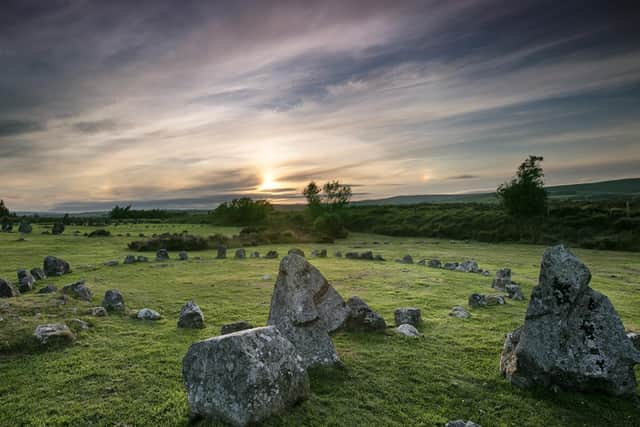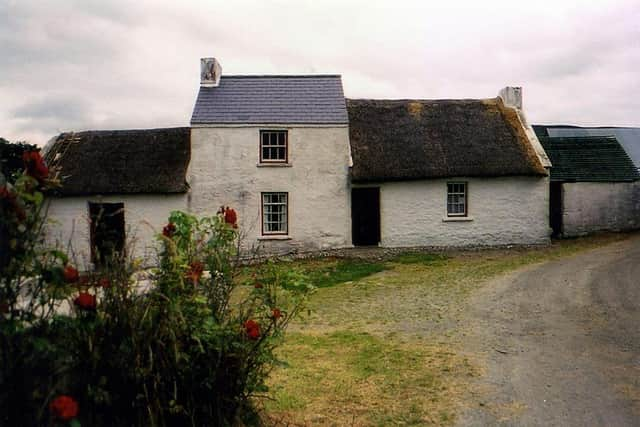10 things you probably didn't know about the history of County Tyrone
and live on Freeview channel 276
The kingdom existed for at least over a millennium, with Dungannon as its capital. However, there are many other fascinating aspects of Tyrone’s history, some of which are listed here:
1. Cookstown’s wide Main Street
A few miles from the border with County Londonderry, and located at the very geographical centre of Northern Ireland, Cookstown boasts the longest main street of any town in Ireland.


Advertisement
Advertisement
135 feet wide and 1.25 miles long, the thoroughfare was constructed in the 1790s in an attempt to outshine the signature boulevards of Edinburgh and Dublin.
Architect William Stewart and his son James fulfilled that dream; because of their efforts, Cookstown was known as ‘Long Hungry Cookstown’ following construction, and its distinctive geography, coupled with the coming of the railway, led to it becoming one of the main centres for the linen trade in Tyrone.
2. ‘Typhoid Mary’
At the age of 15, Cookstown native Mary Mallon emigrated to the United States to live with her aunt and uncle, before becoming a cook for wealthy families. However, while working in New York City, she gained infamy as an asymptomatic carrier of typhoid fever, infecting up to 120 people with the disease. She was forced into quarantine by the authorities, and eventually spent up to 30 years in isolation, before her death in 1938.


To this day, debate rages about the ethics of her incarceration, with some arguing that she was unaware that she carried any disease and others claiming that she knowingly infected the families she worked for.
3. Beaghmore stone circles
Advertisement
Advertisement
Less than 10 miles west of Cookstown lie seven circles, 10 rows of stones and twelve cairns. Meaning ‘big place of birch trees’ the site was originally a dense woodland before being cleared by Neolithic farmers.
Deposits of flint tools have been dated to 2900-2600 BC. Ancient chisel marks on the stones closely resemble the Celtic language Ogham, which was used for magic and divination. Some archaeologists have believed that the circles were constructed to reflect the midsummer sunrise or the movements of the sun and moon acting as calendar markers. The site lay neglected until it was rediscovered by local historian George Barnett in the late 1930s while cutting peat.
4. Strabane and American Independence
Established in the mid-18th century, Gray’s Printing Press served as a long-standing provider of books, newspapers and pamphlets to local communities.
One young Strabane native, John Dunlap, after serving as a young apprentice at Gray’s travelled to Philadelphia and in 1776, his office was responsible for printing the US Declaration of Independence, circulating 200 copies to the thirteen colonial assemblies in what became known as the Dunlap Broadside.
Advertisement
Advertisement
After the Revolutionary War, Dunlap, who also fought for the Americans at Trenton and Princeton, served as printer for the Continental Congress until 1789, printing the Constitution two years earlier. A crucial piece of American history originated in this small town on the banks of the River Foyle.
5. Woodrow Wilson’s link To Tyrone
The paternal grandparents of the 28th President who led the USA through the First World War came from near Strabane. James Wilson worked as a printer, and in 1807, he sailed from the port of Londonderry to Philadelphia, where he became a prominent newspaperman for the Democratic newsheet The Aurora.
Today, the house in which he grew up is owned by the Ulster American Folk Park and can still be found just outside Strabane on the Plumbridge Road.
Woodrow Wilson himself visited Ireland in 1899, although there is no record of him visiting his ancestral home in north-west Tyrone.
6. Dungannon crystal trade
Advertisement
Advertisement
Since the early medieval period, Tyrone has been known for its traditions of glass manufacturing and decoration.
In 1971, at the height of the Troubles, a local priest, Austin Eustace, established Tyrone Crystal to boost employment around Dungannon and the southern portion of the county. Two Austrians - one a cutter, the other a blower - were hired to train the workers with glass jars and bottles until they felt skilled enough to make crystal on their own.
In 1988, the company became the youngest company in the British Isles to be awarded the ISO 9000 for quality. Starting in 2005, they were hired to create the cup for the Canadian Grand Prix. Unfortunately, the factory closed in March 2010, with the loss of thirty-one jobs.
7. A rare Irish stone castle
Outside the village of Newtownstewart, lies a castle built in 1320 by a chieftain of the prominent O’Neill clan.
Advertisement
Advertisement
What distinguishes it from other contemporary structures is that chieftains rarely constructed their fortresses from stone. The fortress consisted of a two-story rectangular construction fronted by the distinctive D-shaped towers (almost like a gatehouse) protruding from the artificial knoll. Behind the towers, a large mound would have been enclosed by a curtain wall, of which only the foundations remain.
